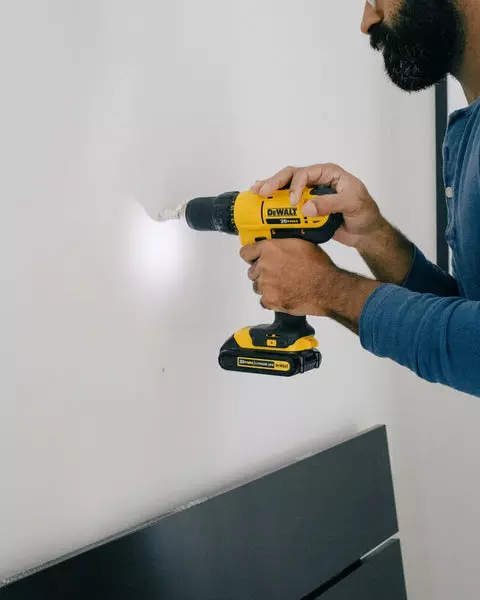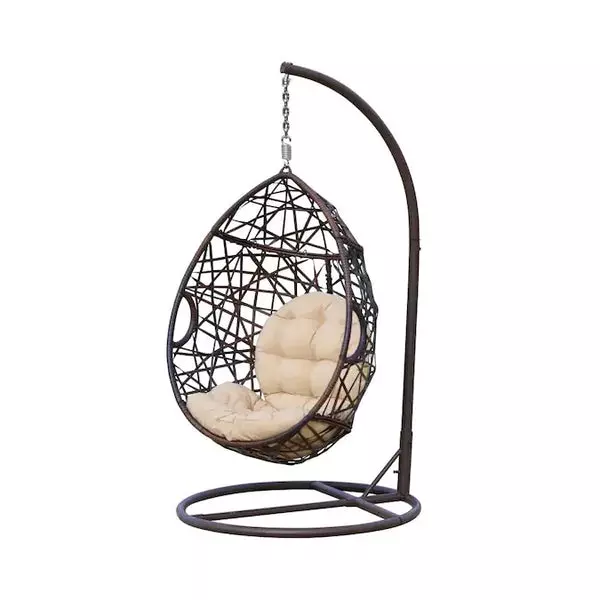
A wooden porch swing is a beloved outdoor furnishing. Swinging in the summer breeze with a glass of sweet tea is an idyllic pastime. But why limit the enjoyment to warmer months? Indoor swings bring a sense of playful whimsy to year-round living spaces. Whether positioned around a cozy fireplace in a den or in a four-seasons sunroom, indoor swings add that extra touch to make even the grayest days stuck inside a treasured memory. They are equal parts unexpected and charming, making them the ultimate fun-factor furnishing that adds a little dazzle to everyday life.
How to Hang an Indoor Porch Swing

Tools
You don't need a whole tool room to hang an indoor swing. Most installation kits do not include mounting hardware and hanging hooks, so it's best to check with the manufacturer for guidelines. Typically, you can find the necessary tools in your house or at a nearby home improvement store. Here's a list of what you'll need:
- Drill
- 3/8-inch bit
- Stud finder
- Measuring tape
- Mounting hardware
- Hanging hooks
While it is possible to DIY the installation, having a partner to help is highly recommended for safety if you choose not to hire a professional.
Step 1: Locate the Ceiling Joists
Before hanging an indoor swing, it's crucial to ensure you have sturdy ceiling joists for safe installation. Make sure your chosen location is structurally sound and can support the weight of the swing. Use a stud finder to identify where the joists are located. Joists are large wood beams that hold the weight of the house, and any weight-bearing object needs to be hung from them. It's important to avoid attaching the swing mount to a ceiling that cannot support it.
Step 2: Choose a Location with Adequate Space
After identifying the ceiling joists, consider the positioning of your swing. Select a spot that allows for a minimum of three feet of space behind the swing and at least 14 inches on either side to prevent it from hitting a wall. This will ensure that you have enough room for the swing to fit and move freely.
Step 3: Installation
Before making any cuts or holes, measure your swing to determine the distance between the hanging hooks. Mark the spots on the ceiling where you'll secure the hooks. For a bench-style swing, you'll need to mount it from two points spaced at least 64 inches apart. Center the first hanging hook on your mark and align it with the joist. Drill pilot holes slightly smaller in diameter than the wood screws. Securely fasten the hanging hook with two screws, and hang a comfort spring from the hook. Attach the chains, cable, or rope to the swing, hanging each side from the ceiling hooks so that the seat is between 18 and 24 inches from the floor.
Step 4: Test Before You Rest
Safety is paramount when it comes to hanging swings. Test the stability of your swing with the help of a partner to ensure it hangs evenly and swings smoothly. Place some weight on the swing before sitting on it to make sure it's firmly in place. Once everything is secure, sit back, relax, and enjoy!
Types of Indoor Swings
Indoor swings have become popular in mainstream interior design, resulting in a wide variety of style options to suit every aesthetic. Here's a quick guide to the most sought-after types:
Bench-Style Swing
Bench-style indoor swings are the most classic take on modern indoor seating arrangements. They are perfect for gatherings and quiet moments of solace. The modern Organic Swing is a great example, offering fun and flexibility. Its adjustable back allows for a variety of seating options, from a lounger for swinging the afternoon away to a comfortable seating arrangement for two. Made with a slender steel frame and inlaid cypress boards, the Organic Swing combines contemporary style and durable materials for both indoor and outdoor use. Dress it up with oversized cushions and blankets to create a plush and cozy seating area.
Hanging Chair

Hanging chairs are a fun way to create a solo sanctuary. While they are best suited for one person, hanging multiple chairs can create a festive seating area if you have the space. Typically made from wicker, rattan, or rope, hanging chairs give off a distinct bohemian vibe. Add a pillow and cushion, and you may never want to get up.
Hammock-Style Swings

Who says hammocks are just for the outdoors? Hammock-style swings are a popular option and come in a variety of colors and patterns to fit your laidback design concept. They naturally distribute their weight evenly, so you only need one anchor point for support. While there is typically only enough room for one person, they provide a relaxing and cozy seating experience.
No-Mount Indoor Swings

If your joists are not strong enough to support a swing or you don't want to drill holes, no-mount indoor swings with stand mounts are available. These are particularly useful if you're in a rental home and want the swing seating experience without any permanent changes. A porch swing, like the Organic Swing, provides the ultimate place for entertaining or slipping away for a quiet moment alone. With the Organic Swing, you can enjoy the luxury of a swing inside the comfort of your home.
Indoor swings are a fantastic addition to any home, bringing joy and a sense of playfulness to your living spaces. From bench-style swings to hanging chairs and hammock-style swings, there are options to suit various styles and preferences. So why not add a little dazzle and fun to your everyday life with an indoor swing?

















